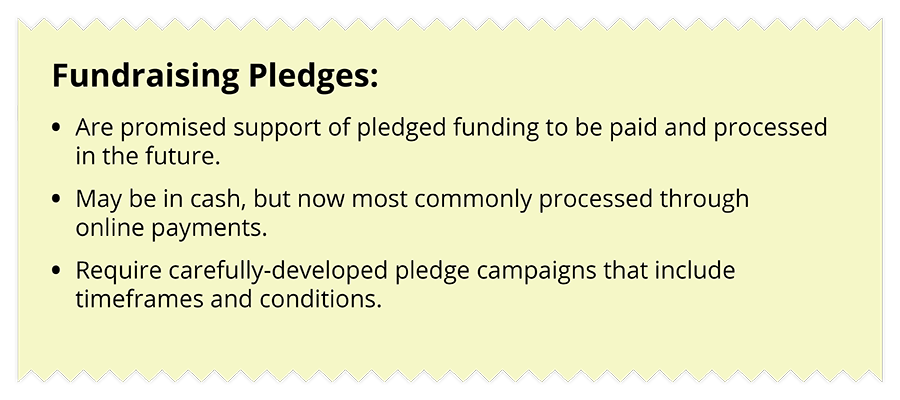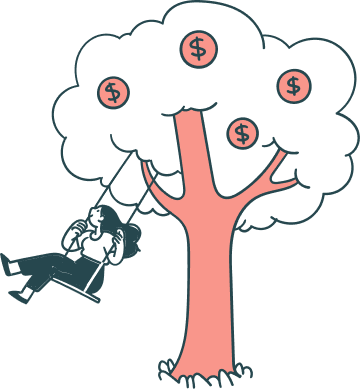Fundraising is an important (if not the most important) activity that nonprofit organizations must conduct on a continual basis. Finding new strategies, donation tools, and engagement techniques can be a struggle. Even as you attract and retain a pool of devoted donors, volunteers, and supporters, it’s still crucial that you continue to grow your base of support. After all, reaching new donors is an essential part of pursuing your mission!
If your fundraising organization is considering conducting a campaign to collect fundraising pledges, your team might be wondering exactly what the difference is between this method and soliciting traditional donations.
Our quick guide will run through the basics and help get you started with next steps:
Use this explainer as a starting point when you being to plan your new pledge campaign. Once you’re ready to move forward, check out our more comprehensive guide to pledge campaigns to help you more fully develop your goals and strategies.

1. Basic differences between fundraising pledges and donations
Both fundraising pledges and traditional donations are gifts made by supporters who believe in your mission and the goals of your campaign. The ways in which you structure your campaigns and solicit each type of donation, however, are fundamentally different.
Let’s run through these differences in more depth:
Compare this to the ways in which you can campaign for and collect traditional donations:
In practice, the differences between these fundraising styles deeply impact the types of strategies and goals that work most effectively with each.

2. The best campaigns and missions for using each donation style
Fundraising is never easy work, but organizing your campaign in a way that sets you up for success can make it just a little easier! Fundraising pledges and traditional donation styles of fundraising are each more appropriate and useful to certain types of campaigns or missions.
Asking for pledged support tends to be a smart strategy if your campaign revolves around any of the following:
- Disaster relief drives
- Advocacy work or protest campaigns around specific social or political issues
- Unexpected or important expenses your nonprofit faces, like moving costs
- Annual fund drives
With the exception of annual fund drives, which can make extremely successful pledge campaigns, fundraising pledges are used in situations where your goals are urgent. Time-sensitive or particularly relevant issues are the most effective.
Campaigning for traditional donations works best in these situations:
- Classic fundraising campaigns and events to fund your programming and mission
- Most types of online crowdfunding or peer-to-peer fundraising campaigns
- In-person donation collections
- Matching gift or other corporate philanthropy drives
- Any other fundraising situation in which donations are collected at that time instead of later
You already know that traditional fundraising campaigns require a great deal of planning and strategy, just as much as for pledge campaigns. Choosing the right tools, engagement strategies, events, online components, and more are crucial to the success of any campaign.
Building a compelling case for support
What unites these two donation styles — fundraising pledges and traditional donations — is the need for a compelling case for support. Donors simply must feel emotionally compelled to give you their support either as a pledge or a direct donation.
While this is true for both styles, it’s especially important for pledge campaigns. Since the idea is to quickly collect promises of support, you have to maintain energy and momentum. An emotionally or socially compelling mission will compel quick action and take your pledge campaigns to the next level. Similarly, you might capitalize on the emotional attachment that supporters feel for your organization, as in a pledge drive for your annual fund.
Your nonprofit’s mission, the project you’re raising money for, your fundraising goals, and time constraints will all play into the development of your pledge campaign. Use them to boost a sense of urgency and create compelling pledge conditions.
For traditional donation campaigns, convincing donors to directly make a gift requires a different strategy. Urgency and emotion are still important, but not quite as crucial as they are for pledge drives. A compelling case for support for a traditional campaign will build on emotion, logic, and evidence of your past work. Of course, every fundraising campaign is different. Let the specifics of your project guide the development process.

3. The right tools for fundraising pledges and traditional donations
Whatever your mission, case for support, or fundraising style, finding the right tools for the job is essential! You’re probably already familiar with some common fundraising tools and donation processing platforms, like these:
- Online donation forms
- Crowdfunding and peer-to-peer campaign pages
- Text-to-give services
These are 3 of the most common digital tools that nonprofits use to accept traditional donations, but what about fundraising pledges?
Top qualities to look for in online or mobile pledge fundraising tools
If you’ve never conducted a pledge drive before, you might be unfamiliar with what to look for in an online or mobile pledge tool. There are a few main characteristics that you should prioritize during your research: speed, ease of use, and flexibility.
As we discussed above, securing fundraising pledges is all about momentum! Make the pledge process fast and easy for your supporters to complete. All you really need from them is their contact information and pledge amounts. Making it any more complicated that can actively hurt your campaign by increasing donor abandonment!
Snowball’s mobile fundraising pledge tool is a great example of a flexible tool that prioritizes user experience. Built on the Snowball suite’s lightning fast 2-click text-to-give platform, this pledge tool secures support for your campaign quickly. Plus, it allows supporters the option to easily complete their pledged donations afterwards!
If your organization is considering starting a fundraising pledge campaign in the near future, make sure you and your team have a clear understanding of the differences between pledges and traditional donations.
The differences between the two styles can have a major impact on the solicitation strategies and digital tools you might incorporate. Think about your mission, project, and goals as you develop your pledge campaign. This helps ensure that all your strategies are aligned to boost your chances for success!
Be sure to continue your fundraising research with some additional resources, too:
- How to Collect Pledges: 6 Steps for Securing Pledged Support. Wrapping up your campaign and collecting your fundraising pledges is one of the most important steps in the process. Follow a few best practices to maximize your results.
- 51 Top-Notch Fundraising Ideas from Bonfire. Get creative with your next fundraising project! Incorporating a unique element into your pledge campaign is always a smart move.
- The Nonprofit Grant Writing Guide: How to Find and Apply for Funding. Grants represent a major source of support for most nonprofits. Get started on your next application today!





